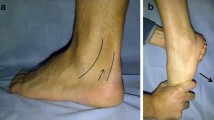Abstract
Purpose
The purpose of our study is to make a retrospective evaluation of endoscopic treatment of Haglund’s syndrome using a new three portal technique.
Methods
All 23 patients (25 heels) with a mean age of 27.7 years were evaluated pre-operatively and postoperatively with parallel pitch lines, the American Orthopaedic Foot and Ankle Society (AOFAS) score and the Ogilvie Harris score.
Results
The mean follow-up was 41 months (range, 30–59 months). There were no obvious complications in our study. In 22 heels, postoperative lateral radiographs showed the achievement of negative parallel pitch lines. The average AOFAS score improved from 63.3 ± 11.9 points pre-operatively to 86.8 ± 10.1 points at final follow-up. There were 14 excellent results, seven good results, two fair results and two poor results. For the Ogilvie Harris score, there were 15 excellent, seven good, one fair, and two poor results.
Conclusion
An endoscopic procedure using the three portal technique seemed to be a safe and efficacious option for surgical treatment of Haglund’s syndrome.



Similar content being viewed by others
Reference
Haglund P (1928) Beitrag zur Klinik der Achillessehne. Zeitschr Orthop Chir 49:49–58
Fiamengo SA, Warren RF, Marshall JL (1982) Posterior heel pain associated with a calcaneal step and Achilles tendon calcification. Clin Orthop 167:203–211
Johannes IW, Aimee CK, Van Dijk CN (2012) Surgical treatment of chronic retrocalcaneal bursitis. Arthroscopy 2:283–293
Van Dijk CN, Van Dyk CE, Scholten PE, Kort NP (2006) Endoscopic calcaneoplasty. Foot Ankle Clin 2:439–446
DeVries JG, Summerhays B, Guehlstorf DW (2009) Surgical correction of Haglund’s triad using complete detachment and reattachment of the Achilles tendon. J Foot Ankle Surg 48:447–451
Sella EJ, Caminear DS, McLarney EA (1998) Haglund’s syndrome. J Foot Ankle Surg 2:110–114
Le TA, Joseph PM (1991) Common exostectomies of the rearfoot. Clin Podiatr Med Surg 8:601–623
Pauker M, Katz K, Yosipovitch Z (1992) Calcaneal osteotomy for Haglund’s disease. J Foot Surg 31:558–589
Ortmann FW, McBryde AM (2007) Endoscopic bony and soft-tissue decompression of the retrocalcaneal space for the treatment of Haglund deformity and retrocalcaneal bursitis. Foot Ankle Int 2:149–153
Jerosch J, Schunck J, Sokkar SH (2007) Endoscopic calcaneoplasty (ECP) as a surgical treatment of Haglund’s syndrome. Knee Surg Sports Traumatol Arthrosc 15:927–934
Van Dijk CN, Van Dyk GE, Scholten PE, Kort NP (2001) Endoscopic calcaneoplasty. Am J Sports Med 2:185–189
Pavlov H, Heneghan MA, Hersh A, Goldman AB, Vigorita VT (1982) The Haglund’s syndrome: initial and differential diagnosis. Radiology 1:83–88
Hua YH, Chen SY, Li YX, Chen JW, Li H (2010) Combination of modified Broström procedure with ankle arthroscopy for chronic ankle instability accompanied by intra-articular symptoms. Arthroscopy 4:524–528
Jardé O, Quenot P, Trinquier-Lautard JL, Tran-Van F, Vives P (1997) Haglund disease treated by simple resection of calcaneus tuberosity. An angular and therapeutic study. Apropos of 74 cases with 2 years follow-up. Rev Chir Orthop Reparatrice Appar Mot 6:566–573
Sammarco GJ, Taylor AL (1998) Operative management of Haglund’s deformity in the nonathlete: a retrospective study. Foot Ankle Int 11:724–729
Pećina MM, Bojanić I (2003) Overuse injuries of the musculoskeletal system, 2nd edn. CRC Press, Boca Raton, pp 270–273
Hamilton WG (1985) Surgical anatomy of the foot and ankle. Clin Symp 37(3):2–32
Nesse E, Finsen V (1994) Poor results after resection for Haglund’s heel. Analysis of 35 heels in 23 patients after 3 years. Acta Orthop Scand 65:107–109
Fowler A, Philip JF (1945) Abnormalities of the calcaneus as a cause of painful heel: its diagnosis and operative treatment. Br J Surg 32:494–498
Chauveaux D, Liet P, Le Huec JC, Midy D (1991) A new radiologic measurement for the diagnosis of Haglund’s deformity. Surg Radiol Anat 13:39–44
Singh R, Rohilla R, Siwach RC, Magu MK, Sangwan SS, Sharma A (2008) Diagnostic significance of radiologic measurements in posterior heel pain. Foot (Edinb) 18:91–98
Angermann P (1990) Chronic retrocalcaneal bursitis treated by resection of the calcaneus. Foot Ankle 10:285–287
Author information
Authors and Affiliations
Corresponding authors
Rights and permissions
About this article
Cite this article
Wu, Z., Hua, Y., Li, Y. et al. Endoscopic treatment of Haglund’s syndrome with a three portal technique. International Orthopaedics (SICOT) 36, 1623–1627 (2012). https://doi.org/10.1007/s00264-012-1518-5
Received:
Accepted:
Published:
Issue Date:
DOI: https://doi.org/10.1007/s00264-012-1518-5




